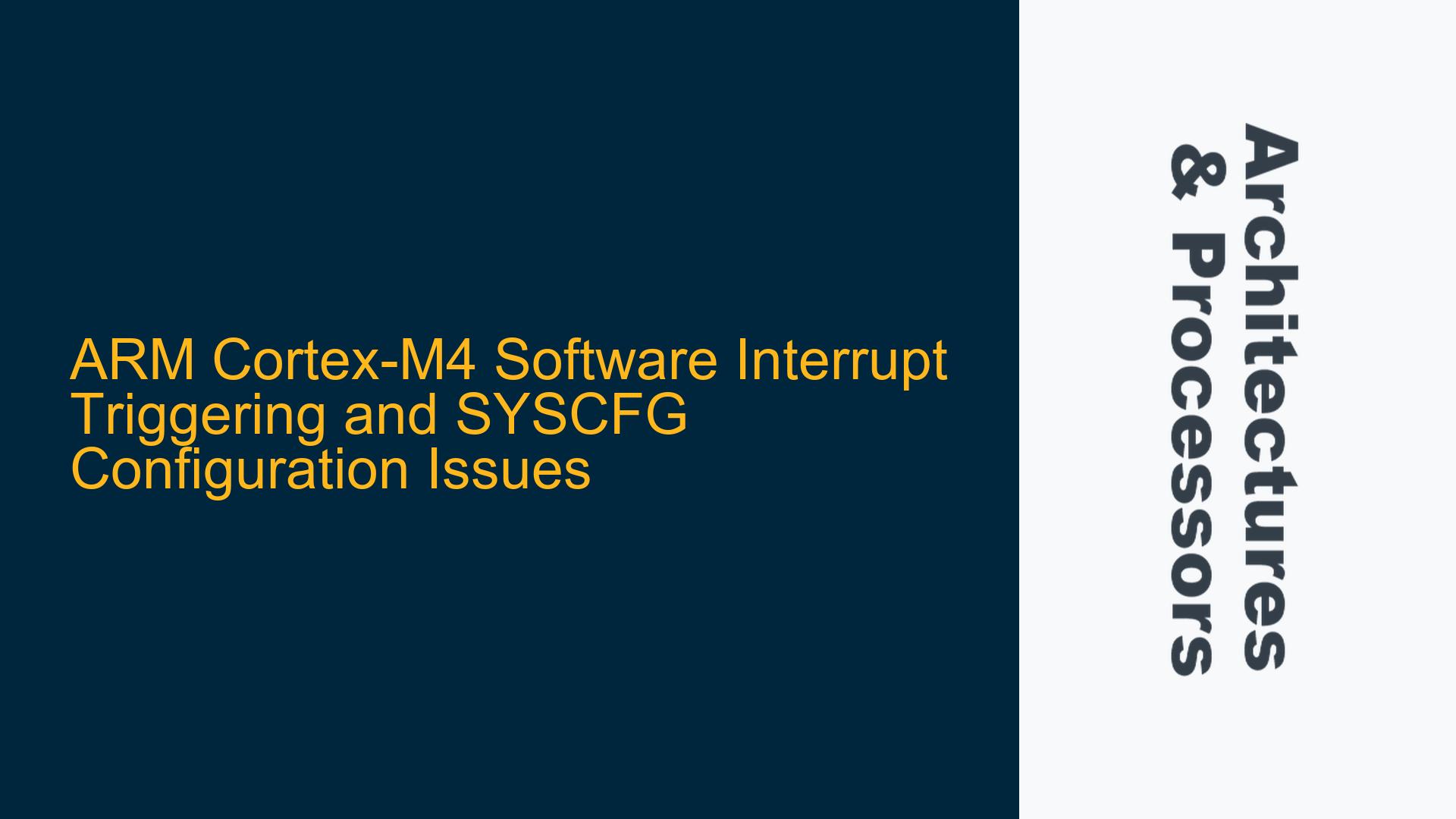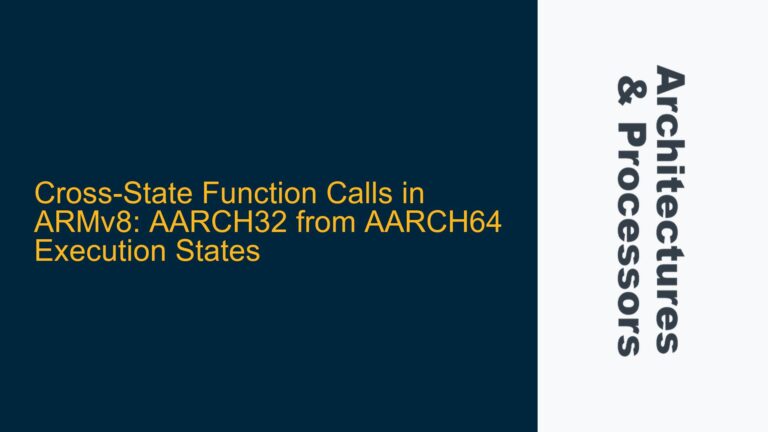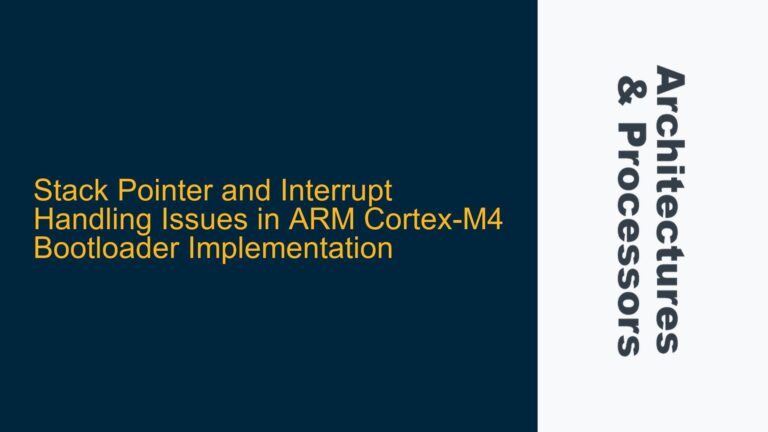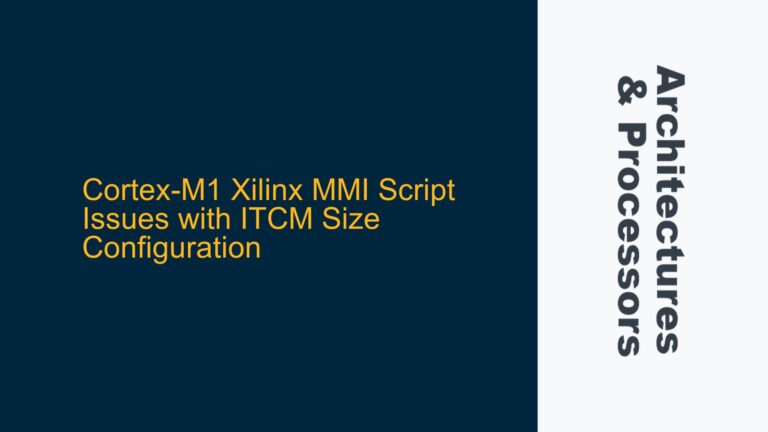ARM Cortex-M4 Software Interrupt Triggering via SYSCFG Configuration
The ARM Cortex-M4 microcontroller, specifically the STM32F429-DISCO variant, presents a unique challenge when attempting to trigger a software interrupt by modifying the System Configuration Controller (SYSCFG) registers. The goal is to manipulate the SYSCFG_EXTICR1 register to configure the EXTI (External Interrupt) lines, thereby triggering a software interrupt. However, the modification of the SYSCFG_Periph.EXTICR1.EXTI.Val field to a specific value (0x7) does not result in the expected changes, leading to the interrupt not being triggered as intended. This issue is further complicated by the use of the Ada programming language and the Ravenscar profile, which imposes strict real-time constraints and limits certain runtime behaviors.
The SYSCFG controller is responsible for configuring the external interrupt lines (EXTI) and mapping them to specific GPIO ports. The EXTI lines are used to generate interrupts based on external events, such as changes in the state of a GPIO pin. The SYSCFG_EXTICR1 register is part of the SYSCFG peripheral and is used to configure the EXTI lines 0 to 3. Each EXTI line can be mapped to one of the available GPIO ports (PA, PB, PC, etc.) by setting the appropriate bits in the SYSCFG_EXTICR1 register. For example, setting the EXTI0 field to 0x7 would map EXTI0 to GPIO port PG.
In the context of the Cortex-M4, the SYSCFG_EXTICR1 register is a 32-bit register, with each EXTI line configuration occupying 4 bits. The EXTI0 field occupies bits 3:0, EXTI1 occupies bits 7:4, and so on. The value 0x7 corresponds to GPIO port PG, which is typically the 7th port in the GPIO port enumeration. Therefore, setting SYSCFG_Periph.EXTICR1.EXTI.Val to 0x7 should, in theory, map EXTI0 to GPIO port PG, allowing for the generation of a software interrupt when the corresponding EXTI line is triggered.
However, the issue arises when the modification of the SYSCFG_EXTICR1 register does not result in the expected behavior. This could be due to several factors, including incorrect register manipulation, improper initialization of the SYSCFG peripheral, or conflicts with the Ravenscar profile’s runtime constraints. The Ravenscar profile is a subset of the Ada language designed for high-integrity real-time systems, and it imposes strict limitations on tasking and runtime behavior. These limitations could potentially interfere with the ability to modify the SYSCFG registers at runtime, especially if the runtime system does not allow for dynamic reconfiguration of hardware peripherals.
SYSCFG Register Access and Interrupt Set Pending Register Misconfiguration
One of the primary causes of the issue is the incorrect or incomplete configuration of the SYSCFG_EXTICR1 register. The SYSCFG peripheral must be properly initialized before any modifications to its registers can take effect. This includes enabling the clock to the SYSCFG peripheral, which is typically done through the RCC (Reset and Clock Control) peripheral. If the clock to the SYSCFG peripheral is not enabled, any attempts to modify its registers will be ignored, leading to the observed behavior where the SYSCFG_Periph.EXTICR1.EXTI.Val modification does not result in any changes.
Another potential cause is the misconfiguration of the Interrupt Set Pending Register (ISPR). The Cortex-M4 provides a mechanism for triggering software interrupts by setting the corresponding bit in the ISPR. This register allows software to manually set the pending status of an interrupt, effectively triggering it without the need for an external event. However, if the ISPR is not properly configured or if the interrupt priority is not set correctly, the software interrupt may not be triggered as expected.
The ISPR is part of the Nested Vectored Interrupt Controller (NVIC), which manages interrupt priorities and pending statuses. Each interrupt has a corresponding bit in the ISPR, and setting this bit to 1 will cause the interrupt to become pending. The NVIC will then service the interrupt based on its priority and the current execution context. However, if the interrupt priority is set too low or if the interrupt is masked, the NVIC may not service the interrupt, leading to the interrupt not being triggered.
Additionally, the use of the Ada language and the Ravenscar profile may introduce further complications. The Ravenscar profile restricts the use of certain language features and runtime behaviors to ensure deterministic execution. This includes limitations on task creation, dynamic memory allocation, and certain types of interrupt handling. If the runtime system does not support dynamic reconfiguration of hardware peripherals, any attempts to modify the SYSCFG registers at runtime may be ignored or result in undefined behavior.
Proper SYSCFG Initialization and NVIC Configuration for Software Interrupts
To resolve the issue of triggering a software interrupt on the ARM Cortex-M4, it is essential to ensure proper initialization of the SYSCFG peripheral and correct configuration of the NVIC. The following steps outline the necessary actions to achieve this:
First, ensure that the clock to the SYSCFG peripheral is enabled. This is typically done through the RCC peripheral by setting the appropriate bit in the RCC_APB2ENR register. For the STM32F429-DISCO, the SYSCFG peripheral is clocked through the APB2 bus, and the corresponding bit in the RCC_APB2ENR register must be set to enable the clock. Without enabling the clock, any attempts to modify the SYSCFG registers will be ignored.
Once the clock to the SYSCFG peripheral is enabled, the next step is to configure the SYSCFG_EXTICR1 register to map the desired EXTI line to the appropriate GPIO port. In this case, the goal is to map EXTI0 to GPIO port PG, which corresponds to setting the EXTI0 field in the SYSCFG_EXTICR1 register to 0x7. This can be done by directly modifying the SYSCFG_Periph.EXTICR1.EXTI.Val field, as shown in the original code. However, it is important to ensure that the modification is performed correctly and that the register is not being inadvertently overwritten by other parts of the code.
After configuring the SYSCFG_EXTICR1 register, the next step is to configure the NVIC to enable the corresponding interrupt and set its priority. This involves setting the appropriate bit in the NVIC_ISER (Interrupt Set Enable Register) to enable the interrupt and configuring the NVIC_IPR (Interrupt Priority Register) to set the interrupt priority. The NVIC_ISER is used to enable specific interrupts, while the NVIC_IPR is used to set their priority levels. The priority level determines the order in which interrupts are serviced by the NVIC, with lower values indicating higher priority.
Once the NVIC is configured, the final step is to trigger the software interrupt by setting the corresponding bit in the NVIC_ISPR (Interrupt Set Pending Register). This will cause the interrupt to become pending, and the NVIC will service it based on its priority and the current execution context. It is important to ensure that the interrupt is not masked and that its priority is set appropriately to ensure that it is serviced as expected.
In addition to the above steps, it is also important to consider the constraints imposed by the Ravenscar profile. The Ravenscar profile restricts certain runtime behaviors to ensure deterministic execution, and this may include limitations on dynamic reconfiguration of hardware peripherals. If the runtime system does not support dynamic reconfiguration of the SYSCFG registers, it may be necessary to perform the configuration during system initialization, before the Ravenscar runtime takes control. This ensures that the SYSCFG registers are configured correctly and that the software interrupt can be triggered as expected.
In conclusion, triggering a software interrupt on the ARM Cortex-M4 requires careful configuration of the SYSCFG and NVIC peripherals. Proper initialization of the SYSCFG peripheral, correct configuration of the NVIC, and consideration of the constraints imposed by the Ravenscar profile are all essential steps in ensuring that the software interrupt is triggered as expected. By following the outlined steps, it is possible to achieve the desired behavior and successfully trigger a software interrupt on the STM32F429-DISCO microcontroller.






